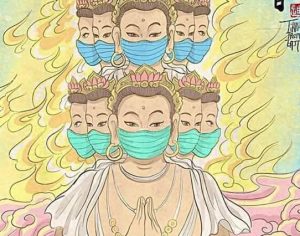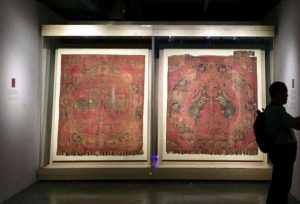
Vimalamitra (Tib: dri med she nyen) was an eighth century Buddhist monk from western India and one of the eight teachers of the great Indian tantric master Guru Padmasambhava. Vimalamitra became an important figure in the history of Tibetan Buddhism and especially within the Nyingma tradition.
Tracing the Legacy of Pandita Vimalamitra (Tib: Vi ma la mi tra’i mdzad rjes nyul ba) is a new research-based book co-authored by scholars of Ngagyur Nyingma Research Centre, the research unit of the Ngagyur Nyingma Institute of Namdroling Monastery in Bylakuppe, South India, established by His Holiness Kyabje Pema Norbu Rinpoche (1932–2009), who was recognized as an incarnation of Vimalamitra.
The book on Vimalamitra’s legacy is the fruit of several years of intensive joint research by the Ngagyur Nyingma Research Centre and the Khyentse Center for Tibetan Buddhist Textual Scholarship (KC-TBTS) at the Department of Indian and Tibetan Studies, Asia-Africa Institute, University of Hamburg. The KC-TBTS was established in January 2011 by Prof. Dr. Dorji Wangchuk, with a grant from Khyentse Foundation. The center is devoted to scholarly investigation of Tibetan (primarily Buddhist) texts, with the aim of gaining a deeper understanding of Tibetan Buddhist philosophy, insights into Tibet’s rich intellectual history and textual culture, and the formal methods and actual practices of translation into and from Tibetan.


In 2013, a meeting between representatives of the KC-TBTS and authorities from the Ngagyur Nyingma Institute of Namdroling Monastery led to the establishment of the Ngagyur Nyingma Research Centre. The first training workshop to be held by both organizations took place in Namdroling in March 2014. More than a hundred monks and nuns from various Tibetan monasteries participated. Subsequently, the Ngagyur Nyingma Research Centre Publication Series was launched, and the first research monograph appeared in 2018. The book on Vimalamitra’s legacy, the fifth monograph in the series, is a study of the deeds of Vimalamitra, in general, and of the Tibetan translations of his commentary on the Prajnaparamita Hridaya Sutra (Skt: Prajñāpāramitāhṛdaya) and its doctrinal content, in particular. The research team has attempted to consider every piece of information that could be traced on both topics. The study also includes an annotated critical edition of the Tibetan translation.
In the foreword by the series’ editors, Prof. Dr. Dorji Wangchuk and Dr. Orna Almogi highlight the value of the research monograph: “It is a remarkable piece of academic work that bears testimony not only to their ability to pursue research but also to the great potential for developing a strong community of researchers in traditional Tibetan Buddhist monastic seminars.”
Buddhistdoor Global had the privilege of discussing the publication of this remarkable book with one of its co-authors, Lopen Ugyen Phuntshok.


Buddhistdoor Global: Why Vimalamitra? How did you choose to write about his legacy? And what is the most important thing we need to know about him?
Lopen Ugyen Phuntshok: We have preferred Vimalamitra as he plays a dynamic role in Buddhism. Likewise, we have chosen Vimalamitra to better understand how he enabled the tradition of Vimala to flourish in Tibet. We say that His Holiness Penor Rinpoche is an emanation of Vimalamitra. So to better know about this, we selected Vimlamitra. The important thing one must know about him is how he was a key figure in spreading the doctrine.
BDG: How long have you been working on the project and is there anything interesting that you would like to share about the working process?
LUP: We have been working on this project for more than five years. Reading the critical edition of his commentary on the Prajnaparamita Hridaya Sutra is an interesting opportunity. Also, reading his biography based on modern research and ancient sayings is extremely interesting.
BDG: Can you share the names of the co-authors?
LUP: The team members are: Khenpo Chophel Norbu, who teaches at a monastic institute in Orissa; Khenpo Kalsang Dhondup, director at the Ngagyur Nyingma Research Centre; Lopen-ma Pema Chokyi of Ngagyur Nyingma Nunnery Institute; and myself, Lopen Ugyen Phuntshok from the Ngagyur Palyul Choekhorling Institute of Bir.


BDG: Who were the teachers or scholars who helped you work on the book?
LUP: Prof. Dr. Dorji Wangchuk and Dr. Ornal Almogi of Hamburg University shouldered the responsibility of absolute and loyal guidance until the date of publishing. Four other senior researchers of the Ngagyur Nyingma Research Centre showered their guidance as well. Lopen Ugyen Tenzin and Lode Phelgyal of the Ngagyur Nyingma Institute helped us with proofreading.
BDG: Can you say few words about the launch of the book?
LUP: The book was launched at Ngagyur Nyingma Institute on 11 September by Khenchen Pema Sherab Rinpoche, the most senior khenpo in the Nyingma tradition outside of Tibet. Also present were board members of the Ngagyur Nyingma Institute, the Penor Rinpoche Charity Foundation, the Ngagyur Nyingma Nunnery Institute, monastic school, and other scholars. Khenchen Rinpoche advised on the importance of education and how research can enrich our knowledge.
BDG: Who is the target audience, since the book is only in the Tibetan language?
LUP: Although our primary targets are monastic scholars, we have also widely targeted Western scholars. Our book is in the Tibetan language, but these days those who are concerned about Tibetan Buddhism can also read Tibetan—we also targeted those readers.
BDG: How does the book contribute to previously existing literature on the Tibetan Buddhist textual tradition?
LUP: We have less confidence to express certainty that our book can contribute to literature on the Tibetan Buddhist textual tradition. Even so, we can say that this is an exemplary book of detailed information, and a biography of Vimalamitra to a certain extent. This book will help modern researchers to comprehend the circumstances of ancient Buddhist traditions.
BDG: Thank you very much! We wish you great success with the book and in all your endeavors!

See more
Ngagyur Nyingma Institute (Namdroling Monastery)
Ngagyur Nyingma Research Centre (Facebook)
Khyentse Center for Tibetan Buddhist Textual Scholarship (Universität Hamburg)
Related features from BDG
Book Review: Meaningful Life Fearless Death: Spiritual Insights on Death, Dying, Hospice Care and Grief Counseling
Book Review: Poetry and Zen: Letters and Uncollected Writings of R. H. Blyth
Mongolian Kanjur from India’s Ministry of Culture Distributed in Russia












